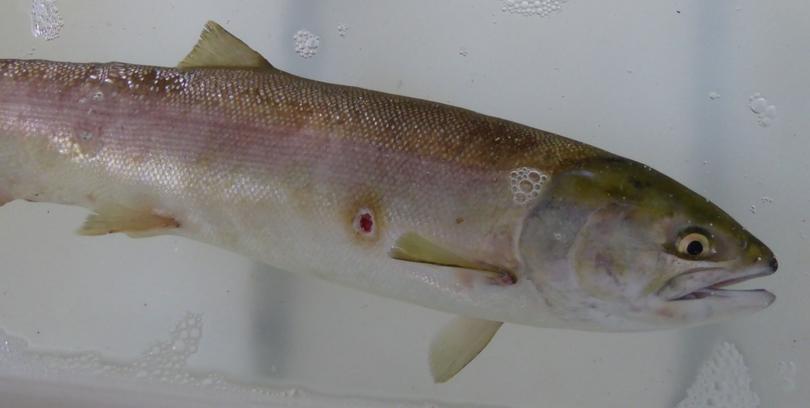forum
library
tutorial
contact

Summer Heat, Drought Took Big Toll
on Upper Columbia River Sockeye
by Mark Yuasa
Seattle Times, December 8, 2015
|
the film forum library tutorial contact |

|
Summer Heat, Drought Took Big Toll
by Mark Yuasa
|
Washington State fishery managers began noticing these dismal conditions when the Upper Columbia opened
on July 1 for sockeye. This could lead to a very small offspring return of sockeye two years from now.
 This past summer's heat wave wasn't kind to sockeye returning to the Upper Columbia River watershed.
This past summer's heat wave wasn't kind to sockeye returning to the Upper Columbia River watershed.
"The sockeye forecast (especially for the Okanogan) was supposed to be good, and it turned out to be the opposite way this time around," said Joe Hymer, a state Fish and Wildlife biologist.
State Fish and Wildlife reported that, out of the 512,000 sockeye that entered the Columbia River mouth this summer, only 10,400 arrived in terminal spawning grounds of the Okanogan River in British Columbia.
The 2015 preseason forecast was 394,000 sockeye returning to the Columbia mouth, of which 285,500 originated from the Okanogan.
The Okanogan sockeye run has been robust in the past six years with annual counts at Wells Dam totaling at least 130,000, and reaching as high as 326,000 in 2012 and 291,000 in 2010.
According to state Fish and Wildlife, no other annual count on a record dating back to 1977 exceeded 81,000. The 2013 return included 148,800 Okanogan fish returning to the Columbia. An estimated 523,700 fish returned in 2014 (forecast was 282,500).
This year's escapement to the Okanogan is the sixth lowest on record since at least 1980 -- the record low was 1,529 fish in 1994 -- despite being the third highest on record to return to the Columbia since at least 1938.
That record-low adult-sockeye return in 1994 produced an offspring adult return of three-year-old fish in 1997 of 25,000, and the four-year-old return in 1998 was 5,000.
Unusually hot weather, a drought and lack of snowpack in the mountains were the likely culprits for the massive die-off as fisheries biologists were seeing warm-water lesions on the fish back in July.
Water temperatures in the Columbia were well above 70 degrees in early summer, and even higher in smaller tributaries. Near the end of July, the water above Bonneville Dam averaged 73 degrees, about nine degrees warmer than the average for the past five years.
That temperature rise -- usually once it goes over 68 degrees -- causes salmon survival to dip drastically, increases chances for disease and creates a thermal block. The majority of sockeye this summer disappeared between Bonneville and McNary dams.
State fishery managers began noticing these dismal conditions when the Upper Columbia River opened on July 1 for sockeye. Fishing was very good until it closed sooner than expected in late July as concerns grew for meeting spawning escapement goals.
This could lead to a very small offspring return of sockeye two years from now.
On the flip side, Hymer reported that the 51,533 sockeye counted at Tumwater Dam on the Wenatchee River this summer amounted to the second highest count since at least 1999 -- the record was 99,899 in 2014.
Lake Wenatchee was open to sport fishing from July 30 and closed on Aug. 16.
State Fish and Wildlife will unveil the sockeye forecasts for 2016 on Dec. 15, and will include forecasts for Cowlitz, Kalama, Lewis, Willamette and Sandy spring chinook; Columbia upriver spring chinook; Snake River spring and summer chinook; and Upper Columbia spring and summer chinook.
learn more on topics covered in the film
see the video
read the script
learn the songs
discussion forum
